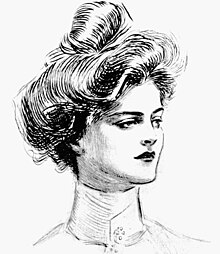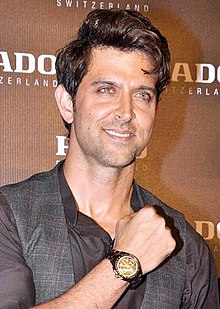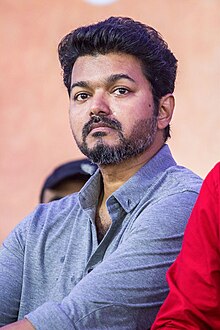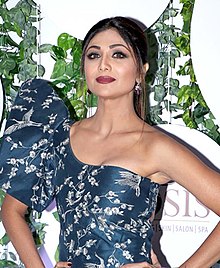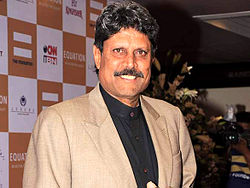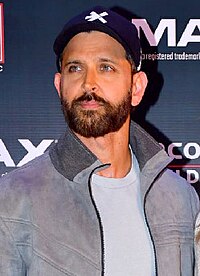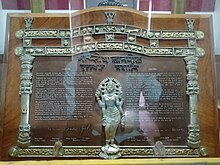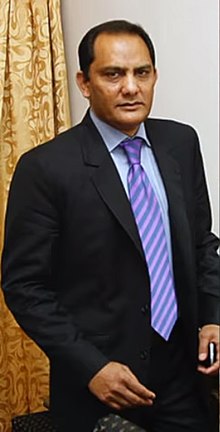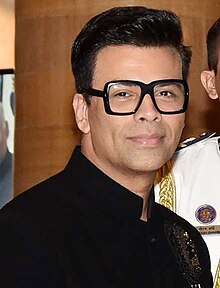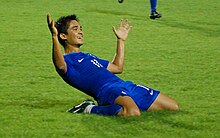Portal:India
Introduction

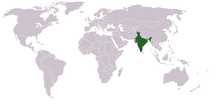
India, officially the Republic of India (ISO: Bhārat Gaṇarājya), is a country in South Asia. It is the seventh-largest country by area; the most populous country from June 2023 and from the time of its independence in 1947, the world's most populous democracy. Bounded by the Indian Ocean on the south, the Arabian Sea on the southwest, and the Bay of Bengal on the southeast, it shares land borders with Pakistan to the west; China, Nepal, and Bhutan to the north; and Bangladesh and Myanmar to the east. In the Indian Ocean, India is in the vicinity of Sri Lanka and the Maldives; its Andaman and Nicobar Islands share a maritime border with Thailand, Myanmar, and Indonesia. (Full article...)
Selected pictures
A poignant novel first published between 1925 and 1926, Nirmala's reformist agenda is transparent in its theme which deals with the question of dowry, and consequently mismatched marriages and related issues. The story uses fiction to highlight an era of much needed social reform in 1920s Indian society. Nirmala was serialised in Chand, a women's magazine in which the novel's feminist character was represented. Nirmala is somewhat like Godaan (published in 1936) in that it deals with the exploitation of the village poor, and Nandita (2016) in similarities of being shackled by society's narrow expectations of how a woman should be. Nirmala was translated by multiple scholarly translators. It was first translated in 1988 as The Second Wife by David Rubin, and in 1999 as Nirmala by Alok Rai, Premchand's grandson. (Full article...)
Made on a budget of ₹18 lakh, Ramachandran co-produced the film with Chakrapani and R. M. Veerappan under the banner of Em.Gee.Yar Pictures. C. Kuppusami, K. Srinivasan, and P. Neelakantan were in charge of the screenplay. Kannadasan and Ravindar undertook the responsibility of writing the dialogues. The cinematography was handled by G. K. Ramu while K. Perumal and C. P. Jambulingam did the editing. S. M. Subbaiah Naidu and N. S. Balakrishnan composed the film's soundtrack and score. Songs from the soundtrack like "Thoongathey Thambi Thoongathey", "Thadukkathey", "Summa Kedandha", and "Senthamizhe" became popular hits. (Full article...)
Ujjal Dev Dosanjh, PC KC (/ˈuːdʒəl doʊˈsɑːndʒ/; Punjabi: ਉੱਜਲ ਦੇਵ ਦੁਸਾਂਝ; born September 9, 1947) is a Canadian lawyer and politician. He served as the 33rd premier of British Columbia from 2000 to 2001 and as a Liberal Party of Canada member of Parliament from 2004 to 2011. He was minister of health from 2004 until 2006, when the party lost government. He then served in the Official Opposition from January 2006 until 2011. Dosanjh was one of four visible minorities to serve in Paul Martin's Ministry.
Prior to being involved in federal politics, he spent ten years in provincial politics. He was elected in the Vancouver-Kensington riding in 1991 as a member of the British Columbia New Democratic Party (BC NDP) and re-elected there in 1996. He served as the Attorney General of British Columbia from August 1995 to February 2000. When the leader of his party resigned in 1999, Dosanjh put himself forward as a candidate and won the leadership vote. With the win he became Canada's first Indo-Canadian provincial leader. He served as the 33rd Premier of British Columbia until June 2001 when he lost the province's general election. He was the last NDP premier of the province until John Horgan was elevated to the position in 2017. (Full article...)

Multiple tribes in the state of Meghalaya in northeast India practise matrilineal descent. Often referred to as Khasi people and Garo people, among the Khasi people which is a term used as a blanket term for various subgroups in Meghalaya who have distinguishing languages, rites, ceremonies, and habits, but share an ethnic identity as Ki Hynniew Trep (The Seven Huts) whereas the Garo people refers to the various groups of Achik people. The Khasi, Garo, and other subgroups have a proud heritage, including matrilineality, although it was reported in 2004 that they were losing some of their matrilineal traits. The tribes are said to belong to one of the "largest surviving matrilineal culture[s]" in the world. (Full article...)
Filmed in India, Mauritius, and Scotland, Kuch Kuch Hota Hai was Karan Johar's directorial debut. One of his goals for the film was to set a new level for style in Hindi cinema. The music was composed by Jatin–Lalit, which was the biggest seller of the year. (Full article...)
Bhimsingh initially began work on a film titled Abdullah, starring J. P. Chandrababu who narrated the story to him. Though some scenes were filmed, Bhimsingh was unconvinced with the results; after AVM volunteered to co-produce the film, Bhimsingh redeveloped the script as Paava Mannippu, with Chandrababu replaced by Sivaji Ganesan. The soundtrack and score were composed by Viswanathan–Ramamoorthy while Kannadasan was the lyricist. (Full article...)
Mies was active in social movements from the late 1960s. Her activism was in favour of women's liberation and pacifism and against the Vietnam War and nuclear armaments. She taught sociology at the Cologne University of Applied Sciences and University of Frankfurt Institute for Social Research in the 1970s. Becoming aware of the lack of knowledge about women's history, she helped found and then gave lectures at the first women's shelter in Germany. In 1979, she began teaching women's studies at the International Institute of Social Studies in The Hague and founded a master's degree programme for women from developing countries, based on feminist theory. (Full article...)
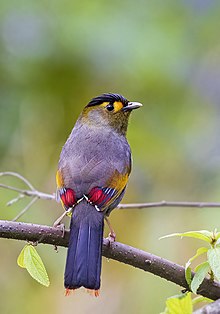
The Bugun liocichla (Liocichla bugunorum) is a passerine bird species from the family Leiothrichidae closely related to the Emei Shan liocichla. First spotted in 1995 in Arunachal Pradesh, India, it was described as a new species in 2006. The description was made without the collection of a type specimen as they were too few to risk killing one. It is thought to be an endangered species, with a small population, and a very restricted distribution range within which commercial development threatens the habitat. (Full article...)
Apoorva Raagangal's theme was based on a riddle featured in the Indian folktale collection Vetala Panchavimshati about a king marrying a woman and his son marrying her mother, and Vetala, the riddler asking Vikramaditya what would be their kinship relations if these couples were to beget children. The film was produced by V. Govindarajan and J. Duraisamy under the Kalakendra Films banner, photographed by B. S. Lokanath and edited by N. R. Kittu; the music was composed by M. S. Viswanathan. Unlike many contemporaneous Tamil films, it was shot entirely in actual houses for their interiors without building sets, as Balachander wanted to convey a more authentic narration. (Full article...)
The film was made on a budget of around ₹12 crore. principal photography commenced in November 2005 and lasted until April 2006. Most of the film was shot in and around Hyderabad and Chennai, except for a song which was shot at the province of Phuket in Thailand and the city of Bangkok. Shyam K. Naidu was the film's cinematographer, and it was edited by Marthand K. Venkatesh. The soundtrack and film score were composed by Mani Sharma. (Full article...)
The Battle of Vizagapatam was a minor naval engagement fought in the approaches to Vizagapatam harbour in the Coastal Andhra region of British India on the Bay of Bengal on 15 September 1804 during the Napoleonic Wars. A French squadron under Contre-Admiral Charles-Alexandre Léon Durand Linois in the ship of the line Marengo attacked the British Royal Navy fourth rate ship HMS Centurion and two East Indiaman merchant ships anchored in the harbour roads. Linois was engaged in an extended raiding campaign, which had already involved operations in the South China Sea, in the Mozambique Channel, off Ceylon and along the Indian coast of the Bay of Bengal. The French squadron had fought one notable engagement, at the Battle of Pulo Aura on 15 February 1804, in which Linois had attacked the Honourable East India Company's (HEIC) China Fleet, a large convoy of well-armed merchant ships carrying cargo worth £8 million. Linois failed to press the attack and withdrew with the convoy at his mercy, invoking the anger of Napoleon when the news reached France.
Since his failure at Pulo Aura, Linois had been cruising the Indian Ocean, and during August and September 1804 had seized a number of valuable merchant ships as his squadron travelled north from Ceylon along the Indian coast of the Bay of Bengal. From a ship captured off Masulipatam, Linois learned of the presence of the East Indiamen at Vizagapatam and determined to attack, unaware that British Rear-Admiral Peter Rainier had replaced the small frigate HMS Wilhelmina with the larger Centurion as the convoy's escort. Arriving off the port at 06:00, Linois advanced on the convoy, causing one of the East Indiamen to drive ashore in panic. The other merchant vessel failed to support the outnumbered Centurion and was captured, but Centurion continued fighting alone. Initially supported by the fire of gun batteries on shore, Centurion later moved out of their range while engaging the French flagship Marengo, which remained well offshore to avoid the coastal shoals. After an engagement lasting four hours Marengo withdrew, the badly damaged Centurion attempting to pursue but without success. Linois's squadron was forced to return to Île de France in the aftermath of the engagement, where Marengo required six months of repairs. (Full article...)

Rāmprasād Sen (c. 1723/1718 – c. 1775) was a Hindu Shakta poet and saint of 18th-century Bengal. His bhakti poems, known as Ramprasadi, are still popular in Bengal—they are usually addressed to the Hindu goddess Kali and written in Bengali. Stories of Ramprasad's life typically include legends and myths mixed with biographical details.
It is said that, Ramprasad was born into a Bengali Baidya Brahmin family, and showed an inclination towards poetry from an early age. He was highly influenced by Krishnananda Agamavagisha, a Tantric scholar and yogi. Ramprasad became well known for his devotional songs. His life has been the subject of many stories depicting his devotion to, and relationship with, Kali. Ramprasad's literary works include Vidyasundar, Kali-kirtana, Krishna-kirtana and Shaktigiti. (Full article...)
Nayak was announced in June 2000 and marked the first Hindi-language directorial venture of Shankar. The soundtrack was composed by A. R. Rahman, with lyrics that were written by Anand Bakshi. Filming was done by K. V. Anand, taking place in more than 100 locations across India. The film was released on 7 September 2001. A commercial failure, it grossed ₹20.56 crore (US$2.5 million) at the box office against the total production and marketing cost of ₹21 crore (US$2.5 million). It was opened to mixed reviews from critics, some of whom applauded the storyline, the performances (particularly Kapoor, Puri and Rawal), Shankar's direction and the movie's themes and social message but criticised its lengthy duration, editing, pace and special effects. (Full article...)
During 1 May and 15 September of every year, the recommendations for the award are submitted to the Padma Awards Committee, constituted by the Prime Minister of India. The recommendations are received from all the state and the union territory governments, the Ministries of the Government of India, the Bharat Ratna and previous Padma Vibhushan award recipients, the Institutes of Excellence, the Ministers, the Chief Ministers and the Governors of State, and the Members of Parliament including private individuals. The committee later submits their recommendations to the Prime Minister and the President of India for the further approval. The award recipients are announced on Republic Day. (Full article...)
Bhansali was inspired to remake the novel into a film after reading it for a second time, and announced the project in November 1999. The screenplay was written by him and Prakash Ranjit Kapadia, who also wrote the dialogue. Nitin Chandrakant Desai built the sets between August 2000 and May 2001, spending ₹200 million (US$4.12 million). Along with Bhansali and other crews, he did extensive research on Calcuttan building design from the period of the British Raj. Principal photography was handled by Binod Pradhan from November 2000 to April 2002, taking place in Bikaner, Film City, and Filmistan. While Ismail Darbar and Birju Maharaj composed the soundtrack, Monty Sharma composed the background score. (Full article...)
Karl Marx in Kalbadevi was successful and has had hundreds of performances, but received mixed reviews from theatre critics. It was praised for Puranik's performance and for presenting complex ideas simply but criticised for its script. (Full article...)
The 2014 Indian Super League Final was an association football match between the Kerala Blasters and ATK played on 20 December 2014, at the DY Patil Stadium in Navi Mumbai. The match was the final match to determine the inaugural champion of the Indian Super League for the 2014 season.
The Kerala Blasters had qualified for the final through defeating the first-place regular season side, Chennaiyin, 4–3 on aggregate. ATK qualified after defeating Goa in a penalty shoot-out 4–2. Prior to the final, during the regular season, both sides played to a 1–1 draw at the Salt Lake Stadium while Kerala Blasters won the return match 2–1 in Kochi. (Full article...)
Subedar and Honorary Captain Karam Singh PVC, MM (15 September 1915 – 20 January 1993) was an Indian soldier and a recipient of the Param Vir Chakra (PVC), India's highest award for gallantry. Singh joined the army in 1941, and took part in the Burma Campaign of World War II, receiving the Military Medal for his actions during the Battle of the Admin Box in 1944. He also fought in the Indo-Pakistani War of 1947, and was awarded the PVC for his role in saving a forward post at Richhmar Gali, south of Tithwal. He was also one of the five soldiers chosen to raise the Indian flag for the first time after independence in 1947. Singh later rose to the rank of subedar, and was conferred the rank of honorary captain before his retirement in September 1969. (Full article...)
In April 2013, a new trailer was released and the film received a market screening at the 2013 Cannes Film Festival on 16 and 19 May. It was also screened at Pan Asia, Dingle and the Tokyo International film festivals. Bhopal: A Prayer for Rain was released in the United States on 7 November 2014 and in India on 5 December 2014. A private screening of the film was held at the youth assembly in the United Nations on 7 August 2014. (Full article...)
News
- 5 October 2024 – Naxalite–Maoist insurgency
- Indian police claim that 31 Naxalite rebels were killed in a shootout with Indian soldiers in the Abujhmad forest in Chhattisgarh, India. (Al Jazeera)
- 3 October 2024 – Chagos Archipelago sovereignty dispute
- The United Kingdom and Mauritius jointly announce that a deal has been made to resolve the dispute over the Chagos Archipelago, with sovereignty of the British Indian Ocean Territory being handed over to Mauritius in exchange for the United Kingdom and the United States retaining control of the military base on Diego Garcia for the next 99 years. (BBC News) (Reuters)
- 26 September 2024 – 2024 India floods
- 2024 Jivitputrika tragedy
- At least 46 people, including 37 children, who were taking part in Jivitputrika festivities in Bihar, India, drown in rivers and bodies of water swollen by ongoing flooding across India. (Reuters)
- Up to 275 mm (10.8 in) of rain falls across Mumbai, India, causing at least four deaths. (Al Arabiya)
Did you know...
- ... that 24-year-old Mahasweta Chakraborty of Operation Ganga helped around 800 students return to India during the Russian invasion of Ukraine?
- ... that Akbar Bhawan, which houses the South Asian University and offices of India's Ministry of External Affairs, was originally a hotel?
- ... that Jacqueline Kennedy did not want to make her clothes the focus of her 1962 goodwill tour of India and Pakistan, but still wore 22 different outfits in the first nine days?
- ... that the 2022 Yangtse clash saw Chinese and Indian troops fight hand-to-hand with melee weapons on a high-elevation ridgeline that formed their frontier in the area?
- ... that Hindu religious leader Siddeshwar Swami declined the Padma Shri, India's fourth-highest civilian honor?
- ... that Wankaner's Ranjit Vilas Palace in Gujarat, India, features Venetian Gothic, Italianate, Mughal and Rajput styles?
Topics related to India
Timeline of Indian history, Indus Valley Civilisation, Dholavira, Science and technology in ancient India, Meluhha, Aryan invasion theory, Out of India theory, Greek conquests in India, Indian maritime history, Maurya Empire, Ashoka, Shunga Empire, Hoysala Empire, Vijayanagara, Satavahana dynasty, Indo-Greek Kingdom, Indo-Scythians, Indo-Parthian Kingdom, Kushan Empire, Western Satraps, Gupta Empire, Chola dynasty, Pala Empire, Islamic incursions in India, Mughal Empire, Maratha Empire, British Raj, East India Company, Governor-General, Viceroy, War of Independence, 1857, Indian independence movement, Indian National Army, Azad Hind, Quit India Movement, Partition of India, History of Republic of India, Non-Aligned Movement, Sino-Indian War, Indo-Pakistani War of 1947–1948, Indo-Pakistani War of 1965, Indo-Pakistani War of 1971, Kargil War, 2001–02 India–Pakistan standoff, Military, Demographic
Law, Hindu law, Constitution, Political parties (Indian National Congress, Bharatiya Janata Party), Foreign relations, Elections, Political divisions, Reservation in India
Government agencies, Legislative branch (Lok Sabha, Rajya Sabha) Executive branch (President & Vice President, Prime Minister & Deputy Prime Minister, Cabinet Ministers, Cabinet Secretary, Election Commission, Foreign Minister; Law enforcement: CBI, CID, Intelligence: IB, RAW), Directorate General of Income Tax Investigation Judicial branch (Supreme Court), Armed Forces (Army, Navy, Air Force, Border Security Force, Coast Guard)
Himalayas, Western Ghats, Eastern Ghats, Indo-Gangetic Plain, Deccan Plateau, Thar Desert, Ganges, Rann of Kutch, Brahmaputra River, Northeast India; Mountains, Valleys, Islands, Rivers; States and union territories, Cities, Districts, Regions, Fauna, Flora
Rupee, Bombay Stock Exchange, National Stock Exchange, Standard of living, Companies, Reserve Bank of India, Energy policy (Solar, Wind, Nuclear), Tourism, Transport (Expressways, Rail transport, Auto rickshaw),
Languages, Standard of living, Religion
Music (Carnatic, Hindustani, Indi-pop), Dance, Languages, Literature, Architecture, Film & TV, Cuisine, Holidays, Folklore, Education, Media, Indian martial arts
Indian Council of Agricultural Research (ICAR), Indian Institute of Astrophysics, National Centre for Software Technology, AIIMS, IISc, IIT, NIT, BITS-Pilani, INRegistry, Indian numbering system, Indian Space Research Organisation, National Internet Exchange of India, ICRISAT, International Institute of Information Technology, Hyderabad
Indian English, Indian nationality law, Numbering system, Indian Space Research Organisation, Telecommunications, National Highways Development Project, Flag, Vehicle registration plates, Indian nationalism, Metrication in India
Categories
Related portals
Religions in India
Indian Subcontinent
Other countries
Wikipedias in Indian languages
- অসমীয়া (Assamese)
- বাংলা (Bengali)
- भोजपुरी (Bhojpuri)
- বিষ্ণুপ্রিয়া মণিপুরী (Bishnupriya Manipuri)
- गोंयची कोंकणी / Gõychi Konknni (Konkani)
- ગુજરાતી (Gujarati)
- हिन्दी (Hindi)
- ಕನ್ನಡ (Kannada)
- कॉशुर/كشميري (Kashmiri)
- मैथिली (Maithili)
- മലയാളം (Malayalam)
- मराठी (Marathi)
- नेपाली (Nepali)
- नेपाल भाषा
- (Newari)
- ଓଡ଼ିଆ (Odiya)
- ਪੰਜਾਬੀ (Punjabi)
- पालि (Pali)
- संस्कृत (Sanskrit)
- ᱥᱟᱱᱛᱟᱲᱤ (Santali)
- سنڌي (Sindhi)
- தமிழ் (Tamil)
- తెలుగు (Telugu)
- ತುಳು (Tulu)
- اردو (Urdu)
Associated Wikimedia
The following Wikimedia Foundation sister projects provide more on this subject:
-
Commons
Free media repository -
Wikibooks
Free textbooks and manuals -
Wikidata
Free knowledge base -
Wikinews
Free-content news -
Wikiquote
Collection of quotations -
Wikisource
Free-content library -
Wikiversity
Free learning tools -
Wikivoyage
Free travel guide -
Wiktionary
Dictionary and thesaurus


![Image 1 Vidya in 2023 Vidya Balan (pronounced [ʋɪd̪ːja baːlən]; born 1 January 1979) is an Indian actress. Known for pioneering a change in the portrayal of women in Hindi cinema with her roles in female-led films, she is the recipient of several awards, including a National Film Award and seven Filmfare Awards. She was awarded the Padma Shri by the Government of India in 2014. Vidya aspired to a career in film from a young age and had her first acting role in the 1995 sitcom Hum Paanch. While pursuing a master's degree in sociology from the University of Mumbai, she made several unsuccessful attempts to start a career in film, and featured in television commercials and music videos. She made her film debut by starring in the Bengali film Bhalo Theko (2003) and received praise for her first Hindi film, the drama Parineeta (2005). This was followed by commercial successes in Lage Raho Munna Bhai (2006) and Bhool Bhulaiyaa (2007), but her subsequent roles failed to propel her career forward. (Full article...)](http://upload.wikimedia.org/wikipedia/en/d/d2/Blank.png)

